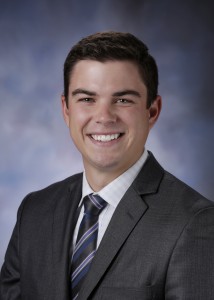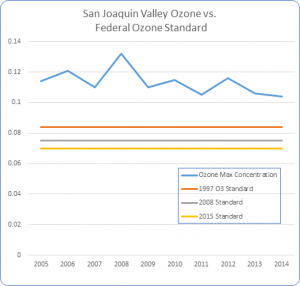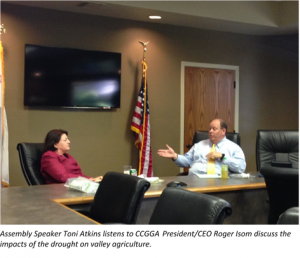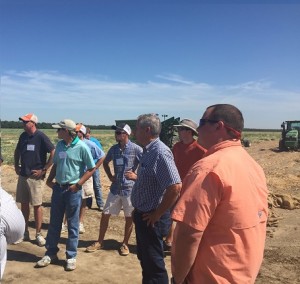Citing “extensive scientific evidence on effects that ground-level ozone pollution, or smog, has on public health and welfare” the U.S. Environmental Protection Agency (EPA) has strengthened the National Ambient Air Quality Standards (NAAQS) for ground-level ozone to 70 parts per billion (ppb) down from 75 ppb! What does this mean for California? Good question. Much of the state has not even written the plan on trying to meet the 75 ppb, because the current requirements are for the 84 ppb standard adopted under the Clinton Administration. To put it in perspective, the San Joaquin Valley just had their cleanest summer on record for ozone, and still exceeded the 84 ppb standard on 75 days. In fact, substantial progress has been made in reducing ground-level ozone. Nationally, from 1980 to 2014, average ozone levels have fallen 33 percent, and the San Joaquin Valley has reduced the number of exceedances of the 84 ppb standard by 54% just since 1996! Depending on the severity of their ozone problem, areas would have until between 2020 and 2037 to meet the standards. In the San Joaquin Valley it will be 2037, and many doubt that this standard is achievable in the San Joaquin Valley, including EPA who stated the technology does not yet exist for the San Joaquin Valley to get into attainment! To take it one step further, the San Joaquin Valley has indicated that this new standard could not be met, even if you took every car, truck and tractor off the road! Nonetheless, EPA has adopted a new standard, and failure to meet the standard will result in penalties on businesses. What that means is that the current truck rule and the potential tractor rule will not be enough to get into attainment and businesses in the San Joaquin Valley will pay penalties as a result…
Author Archives: ccgga
Cotton Harvest Safety Seminar
Wednesday, September 23, 2015
8:00 am- 12:00 pm
Kings & Tulare County Farm Bureaus, UCCE and State Fund will host their annual fall harvest safety training event for cotton and other fall harvesting crops.
Location: Kings County Fairgrounds, 801 10th Ave, Hanford, CA 93230
All farming operations with fall harvests approaching are encouraged to attend, with registration beginning at 7:30 am. This annual safety training will cover topics employers are required to offer: farm equipment safety, road safety, and chemical safety. Training sessions are offered in Spanish and English, certificates of completion are provided to all participants, and complimentary lunch is served afterwards.
For reservations, call Tulare County UCCE office at 559-684-3300.
Deadline to register is Monday, September 21.
Thank you to California Cotton Ginners and Growers, State Compensation Insurance Fund, California Highway Patrol, Kings and Tulare County Farm Bureaus, and University of California Cooperative Extension Service for your support and continued involvement in this harvest day, that now dates back more than 40 years!
Download fill-able registration form
Cotton Harvest Safety Training
Cotton Harvest Safety Training set for Sept. 17
Fresno County Farm Bureau (FCFB), California Cotton Ginners and Growers Associations (CCGGA), California Highway Patrol (CHP), Proteus Inc. and State Compensation Insurance Fund will host the annual Cotton Harvest Safety Training on Thursday, Sept. 17, at the West Side Research and Extension Center, 17353 W. Oakland Ave., Five Points.
The free program will begin with registration at 7:30 a.m. and conclude with lunch at noon.
Registration forms are available online at www.fcfb.org.
For more information, or to register, contact FCFB at 559-237-0263 or info@fcfb.org
FDA Submits Preventive Controls Rules
Today the U.S. Food and Drug Administration has released the Preventive Controls For Human Food Rule and Preventive Controls for Animal Food Rule as under the Food Safety Modernization Act (FSMA). The FDA has stated they will share updates as soon as the final rules are available, saying “documents submitted to the Federal Register can publish several days after they are submitted, with larger documents taking longer to process and display”. The Association will provide more information as it becomes available.
Speaker of the Assembly Visits the Valley
The Speaker of the Assembly in the California State Legislature Toni Atkins was in Fresno, and took time out of her incredibly busy schedule to visit the Association’s office for a lunch meeting with a small group of agricultural organizations to discuss critical issues facing agriculture. The Western Agricultural Processors Association (WAPA) hosted the event. Other organizations involved in the event included the California Cotton Ginners and Growers Association, California Citrus Mutual, California Fresh Fruit Association, Nisei Farmers League and the American Pistachio Growers. As one would expect water dominated the discussion, with talk about the need for increased water storage and the situation in the delta as critical to helping solve the long term water situation in this state. Other matters touched on in the event included climate change, exotic pests, labor issues, transportation and the overall state of agriculture in this time of significant drought. Speaker Atkins has long been a friend to agriculture and we are appreciative she would take time to stop and visit us during her trip to Fresno. Speaker Atkins has previously toured the valley visiting an almond huller, cotton gin and operating a cotton picker. The Speaker will be termed out next year and is considering continuing her work in the State Senate. She currently represents the La Jolla, Pacific Beach, Mission Bay, Old Town, downtown, Coronado Island and Imperial Beach areas of San Diego.
FAQs About The New Paid Sick Leave Law

By Carl Larson
Who qualifies for Paid Sick Leave (“PSL”)?
Employees who work 30 or more days for the same employer providing the leave qualify.
This includes part-time, seasonal, and full-time employees.
Who is excluded from the PSL law’s requirements?
(1) Employers who already provide paid time off (“PTO”) or PSL plans which provide for accrual of sick leave on a regular basis, so long as:
· at least 24 hours of paid time off are accrued by the 120th calendar day of employment, calendar year, or 12-month period; and
· leave carries over at least “3 days or 24 hours” of sick leave from year to year; and
· the leave is permitted to be used for the same purposes allowed in the PSL law.
(2) Employers who provided a PTO or PSL plan to a class of employees before January 1, 2015 that provided leave accrual on a regular basis so long as:
· no less than one day or eight hours of sick leave accrued within three months of
employment each calendar year or 12-month period; and
· employees were eligible to earn at least 3 days of sick leave or paid time off within nine months of employment.
(3) Employers already covered by a collective bargaining agreement that meet certain requirements.
(4) In-home support services employees.
(5) Airline flight deck or cabin crew employees who are already provided with compensated time off equal to or exceeding the requirements of the PSL law.
(6) Public employees who receive a retirement allowance.
Does the PSL Law apply to employees who work in California but are employed by an out-of-state employer?
Yes. All employees who work at least 30 days in California for the same employer are covered regardless of where the employer is based.
How much leave are employers required to provide?
The PSL law generally requires employers to grant employees at least “24 hours or 3 days of leave.” Please note that although the law as written requires 24 hours or 3 days of PSL, this requirement is based on a standard 8-hour day/40-hour week schedule. The legislature did not consider harvesters and other agricultural workers who work a varying schedule that often requires at least 10-hour days. Although the terms “days” and “hours” are not well defined under the new PSL regulations, the safest, most conservative approach in light of the purpose of the statute is to provide 30 hours of PSL for agricultural workers who work a 10-hour day schedule.
What are the use requirements?
Frontloading
· Employers must provide at least “24 hours or 3 days”* of leave at the beginning of each year of employment, calendar year, or 12-month period.
· Leave is not required to be carried over.
· Pro-rating the amount of leave is not permitted.
· Can an employer using the frontloading method pro-rate because of the July 1 start date?
o No. Pro-rating of leave is not permitted by the statute. However, an employer can choose whether to provide the frontloading in each year of employment, calendar year, or other 12-month basis.
Accrual
· Employers may allow leave to be accrued on another basis, so long as it is accrued at regular intervals, and will result in at least 24 hours or 3 days* of sick leave available bythe 120th calendar day of employment.
· Employees accrue leave on the later of July 1, 2015 or their date of hire.
· Leave must be carried over from year-to-year up to a maximum of “48 hours or 6 days.”*
* In accordance with the interpretation of “3 days or 24 hours” agricultural employees who regularly work 10 hour shifts should be allowed to carry over up to 60 hours.
Can an employer use one method for seasonal workers and another for year-round and another for other classes of employees?
Yes. The law permits employers to use one method for one class of employees, and a different method for another class of employees so long as all methods are compliant.
When does accrual under the new law begin?
Accrual begins the later of July 1, 2015 or date of hire for employees who have worked in California for the same employer for more than 30 days in a year.
When can the sick leave be used?
Employees can use sick leave after 90 days of employment.
For what purposes can leave be used?
Employees may take leave for treatment, diagnosis, or preventative care of self, parents, children, spouse, registered domestic partner, grandparents, grandchildren, or siblings.
Employees may also take leave to obtain services or take other steps in dealing with domestic violence, stalking, or sexual assault.
Can an employer limit the amount of sick leave employees can take each year?
Yes. The use of sick leave may be limited to “3 days or 24 hours” of leave each year. Again, the meaning of 3 days in this context is not clear. In the case of agricultural employees regularly working 10 hours shifts, a conservative approach would raise the limit on use to up to 30 hours each year. An employer may also set a minimum increment of two hours for the use of leave.
Is an employer required to “cash out” unused sick leave?
No. The statute does not require an employer to cash out unused sick leave ever. However, unused sick leave is subject to the reinstatement provisions below.
If an employee is rehired within 1 year of termination, is the employer required to reinstate unused sick leave?
Yes. If an employer rehires an employee within 1 year of separation from employment, any unused sick leave accrued by the employee previously must be reinstated.
What are the record-keeping requirements?
The PSL law requires that employers keep records of paid sick leave accrual and use for three years.
How does this affect wage statements?
Employers must provide a written notice that sets forth the amount of PSL available on employee wage statements or a separate writing provided with the statement.
_______________________________________________________
Counsel to Management:
This guide generally addresses compliance with the paid sick leave law in general and the options facing employers. Deciding which of these options best fits your needs, provides a strategic advantage, or how the options apply to your unique situation requires a more in-depth analysis. If you have questions about the paid sick leave law as it applies to your business please contact the Saqui Law Group.
2015 Annual PIE Tour Visits the Central Valley
The National Cotton Council held its annual Producer Information Exchange (PIE) this past week. This program gives an opportunity for cotton growers around the nation to visit other regions within the United States to see how production agriculture works. Attending this year’s trip were growers from Georgia, Alabama, and Virginia. The trip is sponsored by Bayer Crop Science, and the attendees are guided through California by Mike Brueggemann from the National Cotton Council. The tour was kicked off with a visit to the California Cotton Ginners and Growers Association office, with an industry update from President/CEO Roger Isom. The tour included site visits to Terra Nova Ranches with Don Cameron, a tour of Gilkey Enterprises with Kirk Gilkey and other Corcoran-area growers, as well as site visits to Kirschemann Farms, and Ingomar Packing. The group was also able to stop and see some experimental work being conducted by UC Davis Cooperative Extension at the Fresno Facility. The PIE Tour has been an integral part of displaying California’s effectiveness in growing a wide variety of crops. Many of the participants this year were surprised to hear of the diversification that many area growers have on the west coast. We look forward to providing future tours and regulatory and legislative updates to fellow Cotton growers.
Association’s McGlothlin Appointed to Air District Advisory Committee

The Fresno County Board of Supervisors has appointed the Association’s Director of Technical Services Christopher McGlothlin to a three year term on the San Joaquin Valley Air Pollution Control District’s Citizens Advisory Committee (CAC). McGlothlin will serve as the position as the “Industry Alternate” for Fresno County. The CAC consists of 24 primary and 24 alternate members. There is one unpaid representative each for the Industry/Ag, Environmental and City interest groups in Fresno, Kern, Kings, Madera, Merced, San Joaquin, Stanislaus and Tulare counties. The CAC meets monthly and for the purpose of facilitating public input relating to the actions and decisions of the District. This includes providing input on proposed District rules and regulations, District funding sources, study special subjects at the request of the Governing Board and provide recommendations or input on those subjects. This is another shining example of the Association’s level of involvement on critical regulatory and legislative issues affecting our industry!
AMENDMENTS TO SICK LEAVE LAW CURE SOME ILLS, NOT OTHERS
Written by: Carl Larson
Category: General Legal Updates
The long-awaited amendments to the paid sick leave (“PSL”) law have arrived. They make a good number of clarifications, change calculations of sick pay, provide a grandfather clause for pre-existing PTO plans, and lays out how it affects certain state employees. Although the amendments still do not explain how the “24 hours or 3 days of sick leave” translates for employees working 10 hour regular shifts, it is a welcome change from the previous version of the law.
A breakdown of the changes is as follows:
Qualification
Threshold qualification for leave is now employment in California for the same employer for 30 or more days within a year from the commencement of employment.
Broadens the construction exclusion to include construction work not performed onsite.
Excludes retired annuitants of public entities from the PSL law.
Accrual Basis
Allows for accrual on any period basis so long as it is a regular basis and will result in at least 24 hours or 3 days of sick leave available by the 120th calendar day of employment.
No longer limited to using basis of 1 PSL hour accrued for every 30 hours worked.
Can be by pay period or other regularly occurring period of time.
Frontload
Frontloaded sick days are allowed to be provided for each year of employment, calendar year, or 12 month period.
Use of Sick Leave
Allows employers to limit the use of sick leave to 3 days or 24 hours in each year of employment,calendar year, or a 12 month period.
Payment of Sick Leave
Allows three methods of calculating how sick leave is paid and clarifies the formulas regardless of whether the employee has different hourly rates, or is paid by commission or piece rate.
For non-exempt employees:
Method 1: PSL pay is calculated based on regular rate of pay during the workweek in which the employee uses paid sick time whether or not the employee actually works overtime in that workweek.
Method 2: PSL pay is calculated by dividing the employee’s total wages, not including overtime, by the total number of hours worked in the full pay periods of the prior 90 days of employment.
For exempt employees:
Method 3: Paid sick time is calculated in the same manner as the employer calculates wages for other forms of paid leave time.
Employee Reinstatement
Makes clear that an employer who rehires an employee within 12 months of separation is not required to reinstate any paid time off that was cashed out.
Tracking of Sick Leave
Allows employers with unlimited leave policies to indicate “unlimited” on the wage statement.
Makes clear the employer has no obligation to inquire into purposes of sick leave.
PTO Compliance Method
Employers who provide a paid time off (“PTO”) or other paid leave policy (not limited to sick leave) that provides an amount of leave that can be used for the same purposes under the same conditions, do not need to provide additional sick days under the PSL law if:
It satisfies the accrual, carry over, and use requirements of the PSL law listed above.
OR
It satisfies the new grandfather clause:
An employer provided paid sick leave before January 1, 2015 pursuant to a sick leave or PTO policy on any regular accrual basis that resulted in at least 1 day or 8 hours of leave within the first three months of employment of each calendar year or 12 month period and the employee was eligible to earn at least 3 days or 24 hours within 9 months of employment. If the plan is modified from the one in place Jan 1, 2015, then it must comply with the new PSL law requirements.
State Employees
For state employees, leave provided pursuant to specified sections of the government code covering leave or as part of a memorandum of understanding will satisfy the requirements of the paid sick leave law.
Notice Requirements
Delays the notice of PSL rights requirement for employers covered under wage order 11 and 12 to Jan 21, 2016.
___________________________________________________________________________
Counsel to Management:
The new amendments provide a great deal more flexibility in crafting a PSL plan that complies with the law. It will also ease some of the administrative burden of implementing these policies. Check with the experts at the Saqui Law Group to be certain your existing policy complies, and is still meeting your needs.
Regional Whitefly Meetings, July 16th & 17th
University of California’s Cooperative Extension and the California Cotton Ginners and Growers Associations have partnered to host four regional whitefly/Sticky Cotton meetings within the Central Valley. Discussions by Dr. Peter Goodell, Dr. Larry Godfrey and Dr. Bob Hutmacher will include information regarding sugar deposits on cotton lint and the following damage/loss to production, monitoring and management assessment of aphid and whiteflies, review of Best Management Practices including insecticide selection and the managing late season cotton. In addition County Ag Commissioners will discuss the current status of new Chlorpyrifos regulations, a critical product in whitefly and aphid pest control. PCA units have been requested and are pending. Meeting locations & times are Thursday, July 16th 9-11 a.m. at San Joaquin Valley Quality Cotton Growers Association office in Shafter and 12-3 PM at County Line Gin in Hanford, along with Friday, July 17th 10 a.m.-12 p.m. at Westside Farmers Co-Op Gin in Tranquillity and 3-5 p.m. at West Side REC in Five Points. Contact Shana Colby to RSVP at (559)252-0684 or email shana@ccgga.org.


